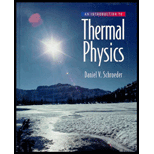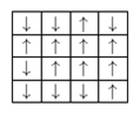
Concept explainers
For a two-dimensional Ising model on a square lattice, each dipole (except on the edges) has four “neighbours”—above, below, left, and right. (Diagonal neighbors are normally not included.) What is the total energy (in terms of

Figure 8.4. One particular state of an Ising model on a
Total energy in terms of
Explanation of Solution
Introduction:
Draw a diagram to show one Ising model on

Here, each dipole has four nearest neighboring dipoles except dipoles on edges.
The lattice in above diagram has 14 nearest neighboring dipoles in between parallel dipoles as well as 19 neighboring dipoles in between anti-parallel dipoles in total.
Write the expression of total interaction energy
Simplify the above expression
Conclusion:
Thus, the total energy is
Want to see more full solutions like this?
- No chatgpt plsarrow_forwardA physics textbook is at rest on a table. If we call the gravitational force exerted on book action, what it the reaction force according to Newton’s third law? Explainarrow_forwardPart I. Addition of vectors a) using the graphical method, add 3.00 cm at 180° and 5.00 cm at 53.1°. Draw the vectors b) using the component method. 2 add 3.00 cm at 180° and 5.00cm at 53.10 again. Include all calculations below. c) what is the magnitude and direction of the resultant nd equilibrant forces of 1.00N force at 30.0° nd 1.00 N force at 150°?arrow_forward
- Part I. Addition of vectors a) using the graphical method, add 3.00 cm at 180° and 5.00 cm at 53.1°. Draw the vectors b) using the component method. 2 add 3.00 cm at 180° and 5.00cm at 53.10 again. Include all calculations below. c) what is the magnitude and direction of the resultant nd equilibrant forces of 1.00N force at 30.0° nd 1.00 N force at 150°?arrow_forwardNo chatgpt plsarrow_forwardNo chatgpt plsarrow_forward
- No chatgpt pls will upvotearrow_forward10. Inx 8.817 11.9.30 × 10-6 12.0.00500010 13.331,000,000 14.6.0005 15.pH=-log[H3O+} = 12.1830arrow_forwardRequired information In a standard tensile test, a steel rod of 1 3 -in. diameter is subjected to a tension force of P = 21 kips. It is given that v= 0.30 and E= 29 × 106 psi. 1-in. diameter P P -8 in. Determine the change in diameter of the rod. (Round the final answer to six decimal places.) The change in diameter of the rod is - in.arrow_forward
 Modern PhysicsPhysicsISBN:9781111794378Author:Raymond A. Serway, Clement J. Moses, Curt A. MoyerPublisher:Cengage Learning
Modern PhysicsPhysicsISBN:9781111794378Author:Raymond A. Serway, Clement J. Moses, Curt A. MoyerPublisher:Cengage Learning University Physics Volume 3PhysicsISBN:9781938168185Author:William Moebs, Jeff SannyPublisher:OpenStax
University Physics Volume 3PhysicsISBN:9781938168185Author:William Moebs, Jeff SannyPublisher:OpenStax Principles of Physics: A Calculus-Based TextPhysicsISBN:9781133104261Author:Raymond A. Serway, John W. JewettPublisher:Cengage Learning
Principles of Physics: A Calculus-Based TextPhysicsISBN:9781133104261Author:Raymond A. Serway, John W. JewettPublisher:Cengage Learning Physics for Scientists and Engineers with Modern ...PhysicsISBN:9781337553292Author:Raymond A. Serway, John W. JewettPublisher:Cengage Learning
Physics for Scientists and Engineers with Modern ...PhysicsISBN:9781337553292Author:Raymond A. Serway, John W. JewettPublisher:Cengage Learning Glencoe Physics: Principles and Problems, Student...PhysicsISBN:9780078807213Author:Paul W. ZitzewitzPublisher:Glencoe/McGraw-Hill
Glencoe Physics: Principles and Problems, Student...PhysicsISBN:9780078807213Author:Paul W. ZitzewitzPublisher:Glencoe/McGraw-Hill Classical Dynamics of Particles and SystemsPhysicsISBN:9780534408961Author:Stephen T. Thornton, Jerry B. MarionPublisher:Cengage Learning
Classical Dynamics of Particles and SystemsPhysicsISBN:9780534408961Author:Stephen T. Thornton, Jerry B. MarionPublisher:Cengage Learning





